The Australian Dollar Parties On Even after Growth Data Taunts Reserve Bank
- Written by: James Skinner
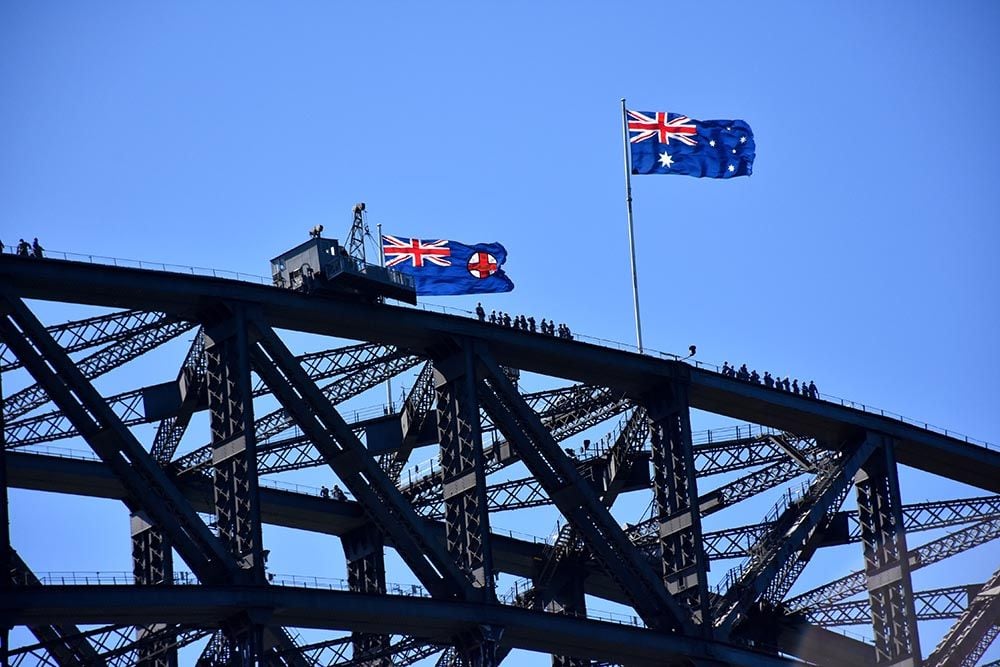
Image © Desiree Caplas, Adobe Stock
- AUD still on front foot despite a weak Q1 growth performance.
- Market already prices more RBA cuts, ringfencing AUD for now.
- ANZ says more cuts needed as Westpac says to sell AUDUSD.
The Australian Dollar continued to march onward and upward Tuesday even after first-quarter GDP data underwhelmed the market, as investors continue to take advantage of the fact that the Aussie has already suffered enough in recent months for its shortcomings.
Australian GDP growth came in at 0.4% for the first-quarter, which is up from the 0.2% pace of growth seen at the end of 2018 but below the market consensus for 0.5% and leaves the annualised pace of expansion running at just 1.8%.
An annual growth rate of 1.8% is below what the Reserve Bank of Australia (RBA) calls 'trend' growth and is insufficient for the economy to generate the inflation pressures required for the RBA to avoid cutting its interest rate again in the near future.
However, the silver lining for Australia's Dollar is that financial markets have already taken one more 2019 rate cut to the bank and are already looking at a third. This is why the Aussie continued to party hard on Wednesday despite the dire economic news.
"The RBA will deliver another rate cut in August. The mild reaction in AUD after the Q1 2019 Australia GDP release is because a September rate cut is fully priced. A more dominant factor for AUD is the risk of a near‑term cut by the US FOMC which is weighing on USD," says Elias Haddad, a currency strategist at Commonwealth Bank of Australia (CBA). "Despite the RBA cutting interest rates to a record‑low 1.25% on Tuesday, AUD/USD is currently trading near a 3‑month high at 0.7000."
Interest rate decisions are normally only made in relation to the outlook for inflation, which is sensitive to changes in economic growth, but have influence over capital flows that tend to move in the direction of the most advantageous or improving returns.
The Reserve Bank of Australia cut its cash rate to a new record low of 1.5% this week but the Aussie Dollar actually rose in the wake of the decision because markets had already priced-in the move and by the time of the cut, were growing concerned about a possible matching rate cut in the U.S.
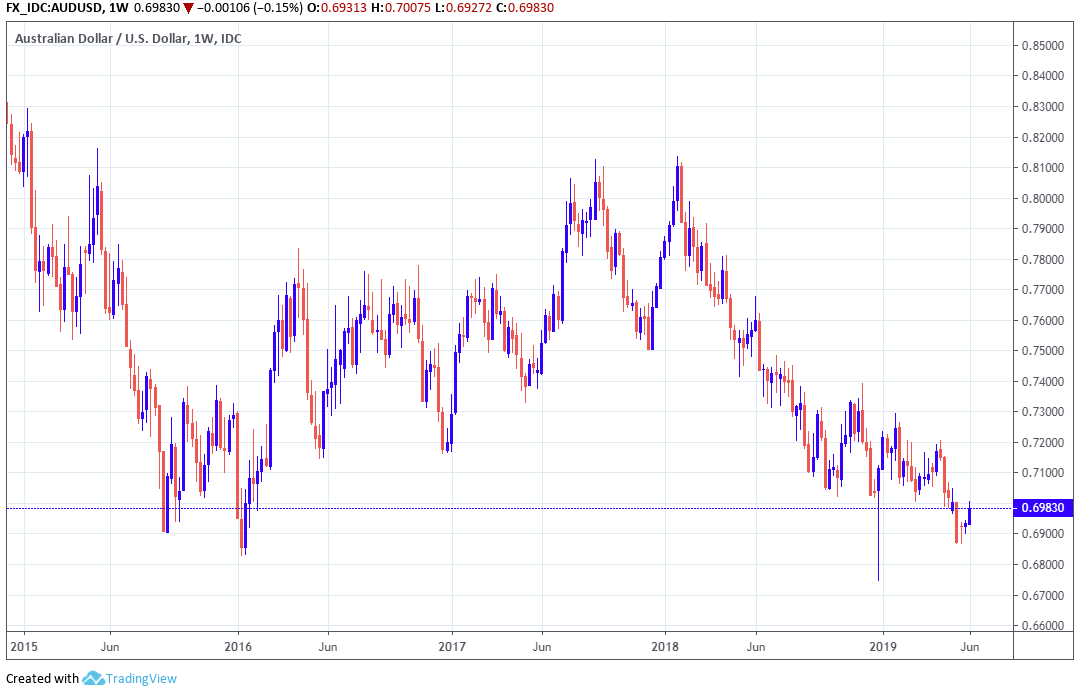
Above: AUD/USD rate shown at weekly intervals.
The AUD/USD rate was 0.07% higher at 0.6995 in morning trading Wednesday and is now down just 0.8% for 2019 after rising 1.15% this last week.
"AUD/USD continues to correct higher and has reached its 38.2% retracement at .6995 and looks set for further gains to its 55 day ma at .7033 and potentially the April peak at .7069. We suspect that it has recently based just ahead of the 78.6% Fibonacci retracement at .6857," says Karen Jones, a technical analyst at Commerzbank.
The Pound-to-Australian-Dollar rate was 0.10% higher at 1.8188 but is now up only 0.48% for 2019 after dropping 3% in the last month.
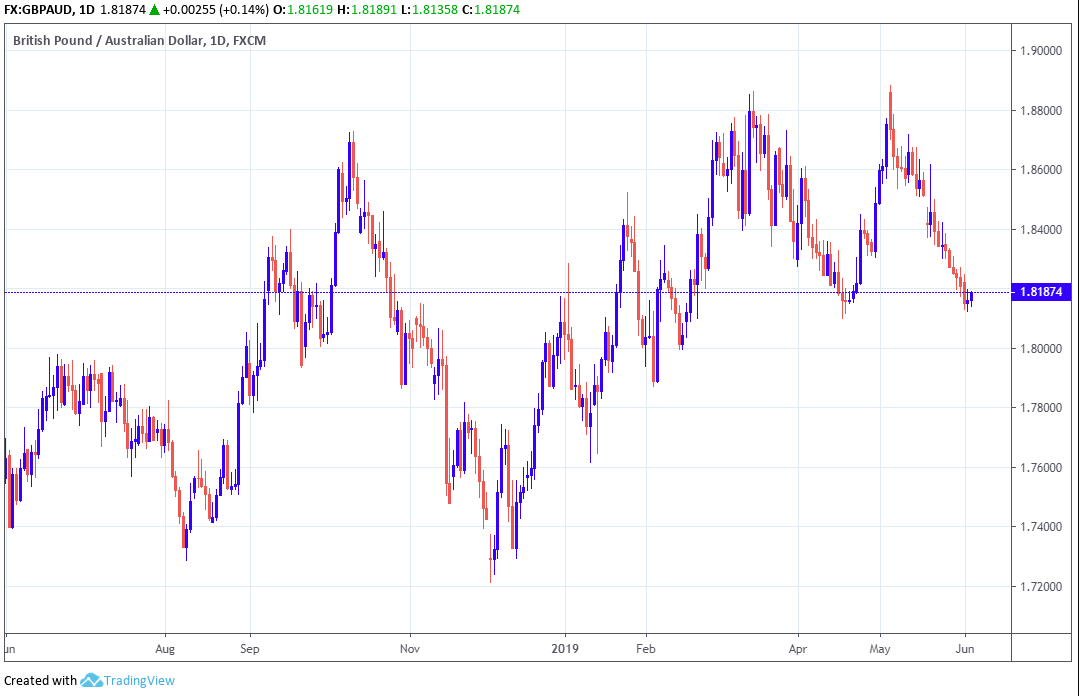
Above: Pound-to-Australian-Dollar rate shown at daily intervals.
Tuesday's rate cut followed years of below-target inflation and came at a time when growth is clearly slowing and the outlook for the Australian economy is souring because of declines in domestic house prices and due to President Donald Trump's trade war.
The RBA had flagged a likely poor performance from the economy in the first quarter but the annualised growth rate announced by the Australian Bureau of Statistics Wednesday is well below the 2.75% GDP growth the bank forecasts for 2019 so if sustained over the coming quarters, could prove a headwind for the Aussie.
"The Bank is likely to be disappointed yet again by these data. The result looks to be less than the average 0.6-0.7% q/q growth the RBA had expected for Q1 and Q2. And unless Q2 partials pick up strongly it suggests that another round of growth downgrades in the Bank’s August Statement on Monetary Policy. The report shows that weakness in the economy has become more broadly based," says Felicity Emmett at Australia & New Zealand Banking Group (ANZ).
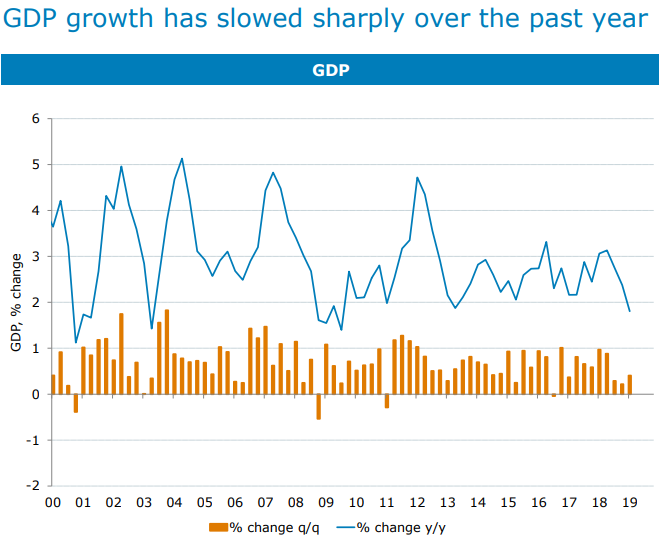
Above: ANZ graph showing changes in Australian GDP growth over long-term and in recent years.
Emmett says Wednesday's GDP data confirms the economy will need hefty stimulus from the central bank in order for growth to pick up and lift inflation into the RBA's 2%-to-3% target band.
The economy is on its back foot due to a struggling household sector and business investment that is not growing fast enough outside of the liquefied natural gas market.
Households are being clobbered by falling house prices, which are damaging confidence, while managing high levels of debt in the absence of meaningful wage growth. All of these factors are depressing consumer spending and could continue to weigh on the economy for a while yet.
Meanwhile, business investment is flagging, possibly due to corporate unease about the outlook for the global economy amidst President Donald Trump's trade war with China. Australia's economy is build on trade in natural resources, demand for which would be hurt in the event of a global economic downturn.
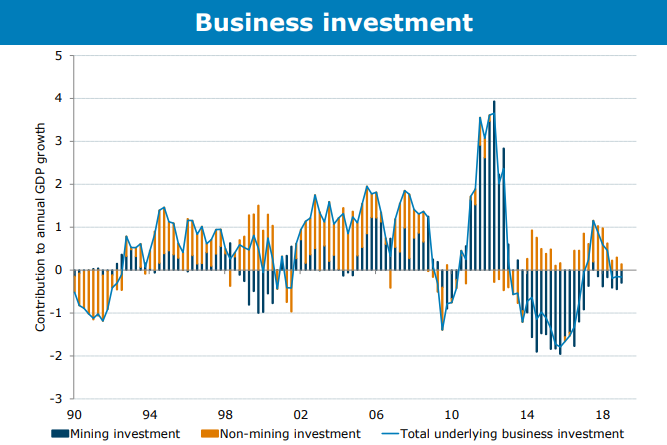
Above: ANZ graph showing changes in Australian business investment over long-term.
"We see the A$ as being capped by 0.70 near term being the midpoint of our fair value band on the basis that offshore risks are rising. In this environment, with iron ore feeling like it has peaked as Australian supply has recovered, the A$ should underperform," says Sean Callow, a strategist at Westpac.
Callow and the team at Westpac, one of Australia's four largest lenders, have told clients to sell the AUD/USD rate around the 0.6985 level. They're looking for a move down to 0.68 to play out over the coming weeks.
Westpac forecasts a total of three interest rate cuts from the RBA in 2019, with the next seen coming in August and the final cut projected to be delivered in November. The market-implied RBA cash rate for November 05 was 0.89% on Tuesday, although it would be 0.75% if a third cut was actually delivered.
Time to move your money? Get 3-5% more currency than your bank would offer by using the services of foreign exchange specialists at RationalFX. A specialist broker can deliver you an exchange rate closer to the real market rate, thereby saving you substantial quantities of currency. Find out more here.
* Advertisement




